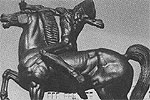
The Loop (continued)
Frontier life was often dull, and Fort Dearborn stood way beyond
the area of white settlement. Whiskey flowed freely between the
traders and Indians, and this became
a bone of contention between the fort and the settlement (See
Fig. 1). In
1812 Captain Whistler and his officers were removed from the
post because
of feud between the Kinzie and Whistler families over whiskey
and the Indian trade. Political influence was a factor even at
this early date in Chicago's history. Captain Nathan Heald was
sent to replace Whistle as commander of Fort Dearborn.
War clouds were gathering in the east as the British navy continued
to disregard American maritime rights. Meanwhile, Tecumseh, the
great Shawnee Indian chief, was gaining influence all over the
old Northwest Territory. Tecumseh watched and waited as war broke
out between the United States and Great Britain in June of 1812.
When the American invasion of Canada failed and Fort Michilimackinac
fell to the British army, thus threatening Detroit, Tecumseh sent
out word that the Americans could be driven back to the Atlantic
Ocean.
While the American forces in the West were retreating towards
Detroit, Captain Heald was ordered to abandon Fort Dearborn and
march with the settlers to aid in the defense of Detroit. On August
15, 1812 Heald led a small column of regular troops, militia,
women, and children out of the fort and south along the lakefront.
Indian braves attacked the column near what is today the intersection
of 18th Street and Calumet Avenue. Thirty-nine men, among them
Captain William Wells, two women, and twelve children were killed,
score were wounded, and others were captured. American control
of Chicago had ended after nine short years. The U.S. Army did
not return until July 4, 1816 to rebuild Fort Dearborn at its
old location near the mouth of the Chicago River.
«
previous
2
of 11
next
»
|
 |

|
 |


Figure
1: Equestrian statues of Indians. »
|